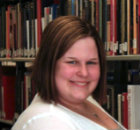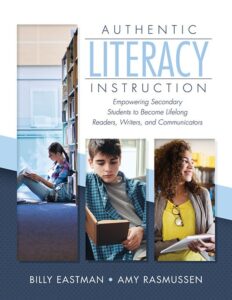Empower Students to Become Lifelong Readers
Authentic Literacy Instruction: Empowering Secondary Students to Become Lifelong Readers, Writers, and Communicators
By Billy Eastman and Amy Rasmussen
(Solution Tree Press, 2022 – Learn more)
Reviewed by Erin Corrigan-Smith
 It seems that every other year teachers are inundated with new ideas (or new names) for literacy instruction. We have experienced a recent “shift” towards a better understanding of what happens cognitively when it comes to literacy understanding, though it may be called many different things.
It seems that every other year teachers are inundated with new ideas (or new names) for literacy instruction. We have experienced a recent “shift” towards a better understanding of what happens cognitively when it comes to literacy understanding, though it may be called many different things.
Making sense of all the ideas behind how to teach literacy – do we teach phenomes, morphemes, sight words, The Science of Reading, etc. – helps make us better in the classroom, regardless of our discipline.

I have recently received my secondary reading endorsement, and I would have loved a practical, no-nonsense, authentic text such as this one while I was attending classes. For most of my endorsement classes, the texts provided were from academic program publishers and there was a strong focus on using (or purchasing) a specific curriculum.
This book offers actionable and honest approaches to literacy instruction for the secondary student (grades 6-12), though the ideas can be modified for younger classes.
For all academic disciplines
Authentic Literacy Instruction’s chapters are organized and presented in a way that follows a natural progression, explaining what literacy is and how to address needs in any classroom. And this text is not just for the language arts classroom; the ideas presented can support reading in all academic disciplines – social studies, science, math and electives.
One of the major focuses of the text is the teacher is the expert in the classroom, and the goal of the text is to help educators be the best literacy teachers they can be by offering more tools to pull from when instructing students.
Though the teacher is presented as the expert, there are clear, research-based ideas presented to help the teacher gain a better and deeper understanding of what it takes to be a literacy instructor.
Reproducibles and reflections
Perhaps the best feature of the text is the “Your Turn” sections found at the end of each chapter that include reproducible pages to facilitate better literacy acquisition within a PLC. (The reproducibles are downloadable at the publisher’s website.)
Throughout each chapter are “reflection” areas that encourage us to consider how the concepts presented can be used within our classrooms. The layout of the text also encourages a “book study” approach to literacy acquisition where teams or disciplines can read and reflect as they collaborate to increase overall mastery across grades.
Practical, actionable, and realistic
The educational community is inundated with information about literacy instruction – each touting itself as being “the best” or “the most research based.” This leads to confusion and an over-saturation of options to consider when addressing literacy needs.
Authentic Literacy Instruction cuts through the literacy fog and presents practical, actionable, and realistic techniques and ideas to use in conjunction with any curriculum. It will help educators increase their literacy knowledge and skills and teach their students with confidence and success.
Erin Corrigan-Smith is a secondary ELA teacher in a suburb of Atlanta. She has a B.A. and M.A. in English, and her focus of study is children’s literature. She has recently returned to school to earn an Ed.D. in Reading and Literacy. In her downtime, she enjoys going to her family’s cabin in the North Georgia mountains with her husband (and her dog) to read, complete her never-ending piles of homework, and relax.




























